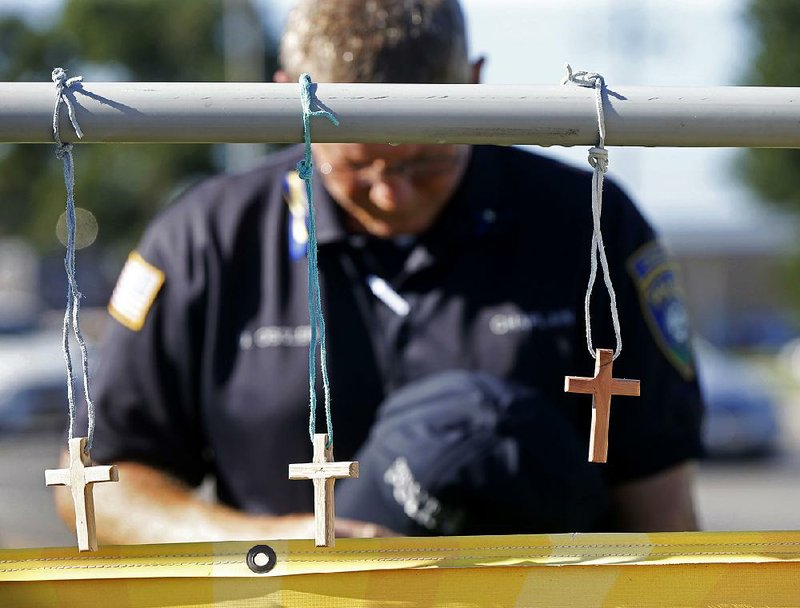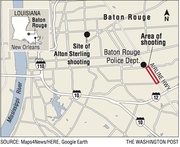Authorities said Monday that they believe the gunman who opened fire in Baton Rouge a day earlier, killing three police officers and injuring three others before he was fatally shot by a SWAT team, was specifically after law enforcement officers in the city.
"There is no doubt whatsoever that these officers were intentionally targeted and assassinated," Col. Michael Edmonson, superintendent of the Louisiana State Police, said at a news conference. "It was a calculated act."
Police say they believe that after the ambush, which came less than two weeks after five officers were killed in Dallas, the attacker could have gone on to continue the violent rampage elsewhere if a Baton Rouge officer had not taken him down with a shot fired from more than 100 yards away.
Hundreds gathered Monday night on the sprawling campus of Healing Place Church in Baton Rouge for a candlelight vigil honoring 41-year-old Matthew Gerald, one of the slain officers. Associate pastor Johnny Green said Gerald had been a member of the church and that Gerald's family was present but had declined media interviews.
Gerald was a Baton Rouge rookie police officer who had just begun his new career after stints in the military.
More prayer services and vigils were scheduled for the area this week.
During the Monday news conference, which lasted for nearly an hour, officials offered a detailed narrative of the shooting, much of it drawn from video recordings Edmonson said captured "the sheer brutality of the shooting."
Authorities used a map to retrace the gunman's movements, describing how the attacker walked and drove through an area packed with businesses, ignoring civilians and instead focusing his fire on officers he encountered. One sheriff's deputy injured in the shooting remained in "very critical condition," East Baton Rouge Parish Sheriff Sid Gautreaux III said.
Autopsies conducted Monday found that the deaths of all three officers were homicides caused by multiple gunshot wounds, said William "Beau" Clark, the East Baton Rouge Parish coroner.
The gunman's autopsy will be conducted today, Clark said.
The shooting came at a time of tension nationwide over race and policing, and it struck officers in a city that has seen some of the most heated protests against police officers in recent memory after police fatally shot a black man named Alton Sterling earlier this month.
The officers were slain just 10 days after the five police officers were slain in Dallas. In successive days before the Dallas attack, police in Baton Rouge fatally shot Sterling outside a convenience store, and officers outside St. Paul, Minn., shot and killed a man during a traffic stop, both high-profile deaths pushed into national headlines by graphic videos showing the encounters or the aftermath.
While police officers were again left on edge this week, officials strongly decried the shooting in Baton Rouge, which left people in Louisiana's capital city feeling shaken and uneasy.
"American flags are again flying at half-staff across the country," Attorney General Loretta Lynch said Monday. "Families are again mourning loved ones robbed from them by senseless violence. Police officers are again grieving for their friends. And all of us are again heartbroken at the news of yet another tragedy, shocked by such callous disregard for human life, and dismayed at yet another instance of violence tearing at the fabric of our nation."
President Barack Obama on Monday ordered flags in the United States flown at half-staff until sunset Friday to honor the officers killed in Baton Rouge, echoing an order he gave 10 days earlier to honor the police officers in Dallas.
Unanswered whys
Edmonson said the gunman -- Gavin Long, a black man and former Marine from Missouri who had posted videos online seemingly endorsing violence as a way to push back against law enforcement -- had been in Baton Rouge for "several days" before the shooting attack. He did not say whether Long participated in any protests that erupted after Sterling's death.
While investigators continued tracing Long's movements leading up to his first encounter with police at 8:40 a.m. Sunday, they were also still trying to unpack what motivated the shooting.
"Why did he come to Baton Rouge?" Edmonson said of questions they hope to answer. "Why did he pick Baton Rouge, why did he pick that location right there, and why did he kill police officers?"
Police also believe that the gunman, who had two rifles and a handgun with him at the time of the attack, would have gone on to kill other law enforcement officers if he had not been stopped.
"After he was finished here, I have no doubt he was headed to our headquarters, and he was going to take more lives," Baton Rouge Mayor Carl Dabadie Jr. said Monday.
The Louisiana State Police said they do not believe that Long made any 911 calls to draw authorities to the area, and instead are looking at whether he knew police officers came through that location to go to the gas station or get coffee.
Investigators are also still working to trace the guns Long had with him Sunday as well as the path of a rented Chevrolet Malibu with Missouri plates recovered at the shooting scene.
Officials said they believe that Long acted alone, but said they are continuing to explore any possible connections Long may have had to people in Louisiana.
"He came here from somewhere else to do harm to our community and specifically the law enforcement officers in our community," Louisiana Gov. John Bel Edwards, a Democrat, said at the news conference. "This was a diabolical attack on the very fabric of society."
Long had lived in Kansas City and, according to a document filed with Jackson County, Mo., last year, sought to change his name from Gavin Eugene Long to Cosmo Ausar Setepenra. In this document, filed with the Jackson County recorder of deeds and first reported by the Kansas City Star, Long claimed his nationality was "Washitaw."
According to law enforcement officials, Long was carrying a Washitaw Nation membership card during the shooting on Sunday. Washitaw Nation is a black nationalist movement that was once targeted by the FBI, and federal courts have characterized it in the past as fictional.
The founder's son told The Washington Post that he didn't know Long and that the group doesn't espouse violence.
Edmonson, speaking Sunday, had detailed just how quickly the event unfolded, describing an encounter that ended in less than 10 minutes. He said police responded to a report of an armed man at about 8:40 a.m., and that four minutes later officers were reported down. Four minutes after that, the gunman was killed, he said.
On Monday, he outlined more about the gunman's specific movements during the attack, while police also released still images showing Long wielding a rifle as he made his way around the businesses.
"There were citizens walking through all through the area, he ... completely dismissed every single one," Edmonson said. "His intentions were accurate, and they were engaging, and they were all aimed at police officers."
Edmonson retraced the steps that Long took Sunday morning. At one point before the gunfire, Long approached a police car in an armed posture, Edmonson said, his gun up as if ready to shoot, only to leave after seeing no one was in there. He then drove his car up Airline Highway, further along the businesses, and parked near the Fitness Expo before going on to confront officers.
He fatally shot one, wounded another, and continued his rampage, Edmonson said. At one point, a deputy sheriff went to his car to run the plates on Long's car, only for Long to come up to the car and begin firing, hitting the deputy in his torso.
"That's the one that's fighting for his life right now," Edmonson said.
Gautreaux said the gunman would've likely killed at least two other officers in the area if Baton Rouge SWAT special weapons and tactics team had not arrived. A SWAT team member killed Long with an improbable shot, Gautreaux said, saying that the officer "had to shoot through structure" to hit the attacker.
The officers killed Sunday were identified as Gerald, a Marine and Army veteran who served in Iraq before joining the Baton Rouge police; Montrell Jackson, 32, also of the Baton Rouge Police Department; and Brad Garafola, 45, of the East Baton Rouge Parish sheriff's office. They left behind grieving relatives and, between the three of them, had seven children, the youngest just four months old.
All of the officers slain Sunday lived just outside Denham Springs, a community across the Amite River from Baton Rouge.
"You hear about these things happening across the country to officers just trying to defend us, but this brings it right here, to our home," Livingston Parish President Layton Ricks said. "These are our families. These are good men. They're the only line of defense between good and evil. We say we don't want to let this evil affect how we live our daily lives. But it does."
Sovereign citizen
Long, a Marine Corps veteran, left behind a social media trail showing that he apparently believed that black people had to physically resist mistreatment from authorities, saying that sometimes it was necessary "to go to war." After five Dallas police officers were gunned down this month by a man who authorities said was angered by police killings, Long posted a video on YouTube saying that he was "not gonna harp on that ... it's justice."
A report from SITE Intelligence Group, which monitors extremist behavior online, said that Long's social media trail showed that "he consistently digested conspiracy theories and sovereign citizen media," referring to a group that believes that the government operates illegally. Officials have warned for years that anti-government groups pose a threat to law enforcement.
Mark Pitcavage, a senior research fellow at the Anti-Defamation League's Center on Extremism, said he first heard of the Washitaw Nation about 20 years ago. The group emerged as an offshoot of the sovereign citizen movement.
"Sovereign citizens rationalize the ability to disobey virtually any law, order, pact, you name it," he said. "It is one of the extremist movements in the United States that targets police. It believes that law enforcement has no jurisdiction over it whatsoever."
In May 2010, two West Memphis, Ark., police officers doing anti-drug work were shot to death by two men later identified to be part of the sovereign citizen movement.
Jerry Kane, 45, and Joseph Kane, 17, wielding AK-47s, shot the lawmen along Interstate 40. Sgt. Brandon Paudert and officer Bill Evans died at a nearby hospital. The Kanes were later killed in a shootout that injured the local sheriff and a deputy at a crowded Wal-Mart parking lot.
Information for this article was contributed by Mark Berman, Adam Goldman, Matt Zapotosky, Kimberly Kindy, Elahe Izadi and Amy Brittain of The Washington Post and by Kevin McGill, Cain Burdeau and Claire Galofaro of The Associated Press.
A Section on 07/19/2016


